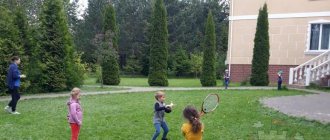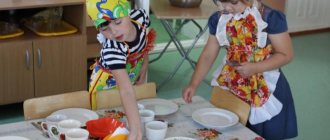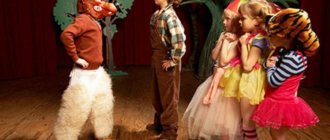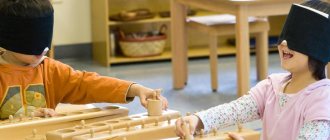Consultation for teachers “Organization of morning reception of children at preschool educational institutions”
Olga Novosadova
Consultation for teachers “Organization of morning reception of children at preschool educational institutions”
The beginning of a new day is of great importance for every person, both children and adults. In relation to preschoolers, it is simply impossible to overestimate the importance of the morning: the mood for the entire next day depends on how they wake up, morning toilet , breakfast. To the number of these indispensable attributes of the morning, one more stage is added - a trip to kindergarten, where the child is met by the teacher and peers.
Morning reception in a preschool educational institution is the process of handing over the child to the teacher or the person replacing him personally, this is a kind of beginning of the little person’s working day, which is organized not by the child himself , but by adults: parents and, of course, the teacher . That is why we , educators, must pay special attention to the subtleties of organizing a reception.
A thoughtful and well- organized morning reception for children is of great importance in the child’s development, daily routine and for the child’s emotional well-being. A friendly meeting with their teacher affects their mood, performance, and discipline. If children know that they are expected to be welcome, they are more willing to go to kindergarten.
Morning reception in kindergarten largely depends on how the adults greeted the child, whether they were happy to see him and how they sent him home in the evening. Friendly intonation, good mood of the teacher, junior teacher (nanny)
conveyed to the children: “Hello, we are glad to see you. Goodbye, we are waiting for you again tomorrow. We'll be glad to see you. Come back tomorrow". If the child was greeted with kind words and kindness, then the child will have a good mood for his further stay in kindergarten. It is assumed that 80% of a child’s positive perception depends on the mood of those around him and the child himself, and 20% on techniques.
What should you start with in the morning ?
1. Reception of children starts at 8 o'clock. To prepare for receiving children , the teacher must come to the kindergarten in advance, prepare all the material - games, pictures, etc.
2. Children can be received both indoors and outdoors. In good weather, receive children in the fresh air at any time of the year. Of course, there may be exceptions to this. For example, if a teacher starts working with a new group of children and does not know them very well yet. Or he receives a group of children who, at first, find it difficult to part with their loved ones; in such cases, it is more advisable to organize their reception in a room where it is easier to divert the children’s attention.
3. The daily morning reception of children should begin with the fact that the teacher, when meeting them, must smile and greet the child and parents.
4. Then there is a preventive examination of their pupils. Knowing well the individual characteristics of the children in your group , you can already determine by appearance whether the child is healthy. As a rule, healthy children, when they come to kindergarten, begin to play, willingly communicate with each other and with the teacher, and move a lot.
5. A conversation with parents about how the child slept and what mood he woke up in will help the teacher find the key to the child. It also happens that they came to kindergarten already with whims, then we find out the reason for the bad mood. If there is a suspicion that the child is not healthy, then the temperature must be measured in front of the parents. If the disease is discovered after the parents leave, then we isolate him from other children , put him to bed, inform family members about the incident and invite a medical professional.
During a conversation with parents and the child, you can immediately see whether the children are dressed for the season and, if necessary, give short advice to the parents on raising the child or suggestions for the child’s clothing.
6. The teacher thinks in advance about how to organize the children’s activities and keep them busy with useful things during the period from reception to preparation for breakfast. At this time, children mostly play.
— The teacher prepares games and toys, arranging them in such a way that it is convenient for children to take them and play without interfering with each other.
— The teacher encourages games that arise on the initiative of the children , helps to implement their plans, creating the necessary conditions for this.
“He can offer children a variety of didactic games that are already familiar to them, as well as outdoor ones, which are played both on the site and indoors.
7. Children’s work activities can be organized in the morning . At a younger age, children in arranging toys, invites them to change clothes for a doll, etc. Kids carry out work assignments under his supervision and with his help. Thus, by involving children in various activities, the teacher forms in them the habit of being constantly busy.
Of course, the first minute is praise, kind words accompanied by music. You can invite children to join a group in an unusual way “to fly like a leaf to other leaf children.”
or
“spin like a snowflake”
to the music. This game transformation will give positive emotions to both children and teachers.
An observant teacher sees in what mood the child came to kindergarten and shows pedagogical tact : either immediately attracts the child to the activity, or gives him the opportunity to be alone and calm down.
To establish emotional contact, a pre-prepared environment for receiving children . Organization of the environment involves creating conditions to protect the nervous system of children from excessive excitement. to organize the environment appropriately , select benefits (music, quiet play, fairy tales with good characters, incentives)
.
We suggest paying special attention to such a method of morning meeting as surprises - toys, balloons, homemade products, dolls from the group. They are unusual, bright, musical, mechanical, etc., surprises that are already waiting for the child, as if they came to support the baby on his first day in kindergarten, after leaving due to illness, a long absence, or on his birthday. In a nursery group, where very young children come, the teacher should try to caress, calm, and distract with affection, kindness, love, warmth. During the adaptation period, the child misses home, is not able to communicate with other children, and is in a depressed state. Songs, nursery rhymes, bright toys help to find contact and extinguish negative emotions. A nursery rhyme read encourages children to take action , creating a joyful mood.
But reluctance to go to kindergarten sometimes manifests itself in those children who have been attending preschool for a long time. The reasons may lie in the child’s health, overwork, failure of adults to fulfill promises, etc. Sometimes parents, rushing to work, begin to undress the child, causing his protest, or, on the contrary, spend a long time persuading him. The teacher should talk with such parents, convince them that all this has a negative effect on the baby, affects his mood, and that after his loved ones leave, he cannot calm down for a long time.
To quickly distract a child, you should switch his attention to something interesting. This can be done in different ways : give a small assignment, watch something interesting together, offer board games, didactic games.
Games in the morning are of great importance for maintaining, and sometimes even creating, a calm, but at the same time active and joyful mood in the child. As for educational toys, in the morning children are given free use of toys that are already familiar to them (they select, if possible, ones that are not noisy)
: cars, carts. Playing with them encourages kids to take energetic action and brings satisfaction.
Therefore, it is necessary to arrange toys so that they attract children’s , encourage them to act with them, and enrich the little existing experience of acting with these toys (dolls and cars, building material, sensory toys, etc.)
.These toys are placed in play corners: dolls can be placed in a stroller, car, or on a high chair.
Nearby you can place kitchen utensils and dessert utensils, a stove, items for washing and ironing. Even at the beginning of the year, such toys unite children , although they do not require coordination of actions.
At the same time, the teacher must ensure that each child finds a game for himself. children in the group , you can bring a new toy or game, show it to the kids, and give it to them to play with. Later it is better to temporarily remove it. Considering that the teacher is largely busy with receiving children , toys and aids that require constant supervision by an adult are removed (mosaics, cut-out pictures)
.
Building materials located on several tables help organize children well For this purpose, the teacher can build a simple structure from building material the children
a bridge along which you can carry nesting dolls;
gates through which children bring their cars;
a fence behind which there are animals.
You can celebrate the baby’s renovation, praise the drawing that the child brought. As for the child’s clothing, it is very important when receiving children to pay attention to his appearance. Having noticed problems, you can invite the child to put himself in order, help him if necessary, thus developing the habit of always being clean and tidy.
If a child is naughty, you need to distract him, find a way to help the child relax, stroke him, set him up for good, and not rush him or shout. older children : “What amazing thing did you see on the way to kindergarten, who did you meet?”
After finishing the reception of children , morning exercises .
After morning exercises, as a rule, there is a Morning Gathering (group gathering or morning circle )
- this is a regime moment, which is a form
of organizing the educational process during joint activities of adults and children .
The main purpose of holding a morning meeting is to “set the tone”
throughout the day, that is, to create a positive emotional mood and instill in the child confidence that he will feel good among his peers, and the day promises to be interesting and eventful.
Tasks :
- forms primary ideas about the rules of behavior in society;
- allows children to feel their importance, confidence that they are accepted among their peers for who they are.
-Morning assembly helps children learn to play not side by side, but together, being tolerant of each other.
— Creates conditions for communication between children and adults : children learn to structure a conversation correctly (for example, give a friend the opportunity to speak, get used to the daily routine (for example, changing clothes upon arrival at kindergarten, parting with a parent, playing games, preparing for breakfast, etc. ) Works on developing cultural communication skills.Kids, when they come to the group, receive compliments on new clothes, hairpins, hairstyles, etc.
The pedagogical discoveries of modern educators will delight children , create a favorable psychological atmosphere in the group, and also create a trusting relationship between parent and educator.
Premises treatment
Every morning begins with intensive cleaning of the premises with disinfectants. Processing is carried out before the children arrive. And once a week you need to do general cleaning. During the day, it is important to adhere to the following rules:
- ventilate rooms with through air every 2 hours. There should be no children there at this time;
- during breaks, disinfect surfaces - toys, tables and other furniture;
- use devices for air disinfection;
- Kitchen workers must wear gloves and disinfect utensils and tables after each use.
Important! Disinfectants must be chlorine-free. A five-day supply of treatment products should be kept in the kindergarten.








